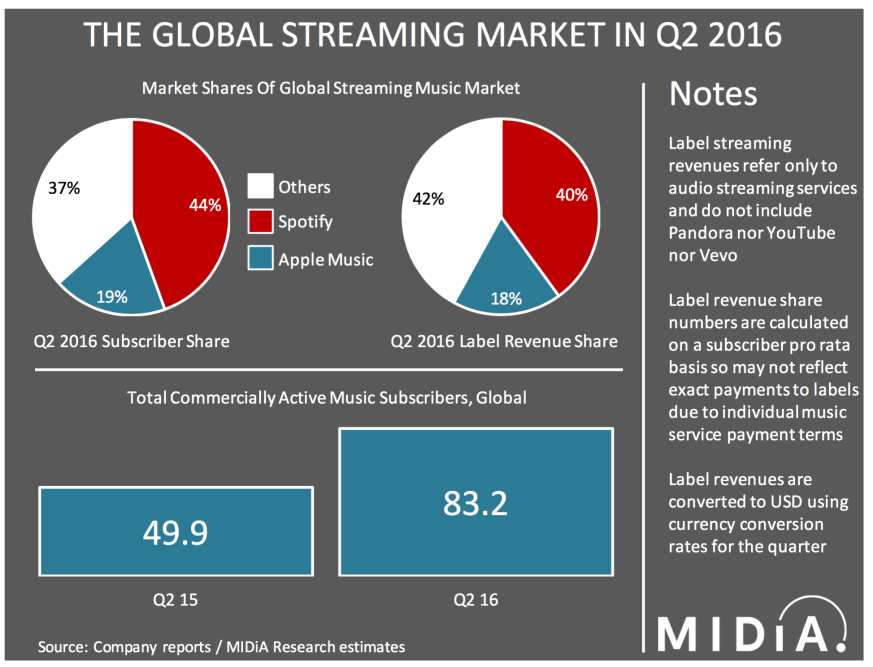Did Apple Music, Spotify Just Win The Streaming Wars? [Mark Mulligan]
Although streaming in general has seen strong growth in 2016, it seems this recent build in subscribers has largely been isolated to two major players in the streaming wars, Apple Music and Spotify, leaving smaller contestants in the dust.
____________________________
Guest Post by Mark Mulligan on his Music Industry Blog
Spotify has just delivered 2 landmark data points: 40 million subscribers and $5 billion paid to rights holders to date. Although the 3 million added in Q3 was down on the 7 million added in Q2 (boosted by a summer pricing promo) there is no escaping the fact that Spotify’s momentum has accelerated rather than declined since the emergence of Apple Music. 2016 is proving to be Spotify’s year. The question is how well the rest of the market is performing beyond the 2 market leaders?
The streaming music market as a whole is experiencing unprecedented growth, with the major labels collectively reporting a 52% increase in streaming revenue in Q2 2016 compared to the same period 12 months ago. Given that total streaming revenues (including YouTube etc. but not Pandora) grew by 44% in 2015 (according to the IFPI) the picture that is emerging is one of, at worst, sustained growth, at best, accelerating growth.
Although the major label numbers have to be interpreted with caution due to factors such as Minimum Revenue Guarantees (MRGs) – see my previous post for much more detail on this – the headline trend is growth. However, headline growth is not necessarily a reflection of how most of the market is actually performing. In fact, a forensic examination of these numbers cross referenced against reported Apple Music and Spotify numbers reveals that the outlook for the rest of the pack is very different indeed.

At the end of 2015 there were 67.5 million subscribers, by the end of June 2016 that had increased to 83.2 million – a 23% increase from the end of 2015 and a 63% increase on Q2 2015. Spotify’s subscriber count for Q2 2016 was 37 million (including super trialists) while Apple Music was just under 16 million. This gives them a combined market share of 56%, which in itself is not particularly surprising. However, when we look at what has happened to the rest of the pack that things start to get really interesting…
The Rest Of The Pack Is Getting Left Behind
By end Q2 2015 Spotify had 20 million subscribers and Apple Music none. This meant that the rest had 31 million between them. By Q2 2016 this ‘remainder’ had shrunk to 30.5 million. Among this chasing pack there is a diverse mix of stories, with some services showing solid growth, some losing lots of paid subscribers and some disappearing all together. Meanwhile Spotify and Apple Music added 32.7 million to the global subscriber base. Thus over the same 12 month period these two players combined, became bigger then the entire rest of the market in subscriber terms with a 63% combined market share. An interesting side note: Tidal’s reported revenues of $47 million in 2015 mean that it can’t have had more than around 800,000 commercially active subscribers by year end, which means that the reported and ‘implied’ 4.2 million current subscriber count is probably closer to half that.
Streaming revenue followed a similar trend with Apple and Spotify dominating and the rest falling slightly (by 1 percentage point year on year). Spotify paid around $1.6 billion in royalties in 2015 and a cumulative $6 billion by September 2016, implying about $1.1 billion in 2016 already. The amount that Spotify paid to record labels in Q2 was somewhere between $479 million and $622 million, depending on when and how Spotify paid for those 7 million new super trialists it acquired that quarter. Towards the lower end of that range is probably the safer bet. Apple by comparison paid around $220 million. And as with subscriber numbers, the rest of the pack lost revenue.
It’s A 2 Horse Race
When Apple launched Apple Music some less informed observers suggested that it was too late to the party and that there was only room for one big player. The numbers from Q2 2016 show that Apple was far from too late (fashionably late perhaps) and that the rather than being a winner takes all scenario, the streaming market is a 2 horse race. Unfortunately for the rest of the pack it does look like there is only space for 2 leading global players, with Apple clearly having played a key role in knocking Deezer out of 2ndplace and racing on ahead.
Still A Place For Regional Leaders
This does not mean that there is not space for other players, there is. Especially regional leaders like QQ Music, KKBox, Anghami and MelOn. But the consumer marketplace only has so much appetite for global scale $9.99 AYCE services. Which is why pricing and product innovation are so crucial if the recorded music business wants a vibrant streaming sector. Compare and contrast with the streaming video market where there is immense innovation with niche services and a diverse range of price points. Music streaming needs the same approach. Tidal may have (very successfully) differentiated on brand and content but it remains fundamentally an also-ran, $9.99 AYCE service. As things stand, the only really serious attempt to play by different rules is Amazon’s steadily emerging streaming strategy. Expect that dark horse to make up ground by playing by different rules. Perhaps even Pandora may be able to break the mould too.
But it is only through differentiated strategies that serious inroads can be made and unless pricing and product innovation occurs (and the labels and publishers need to enable it) expect the streaming race to continue to be a tale of 2 horses.